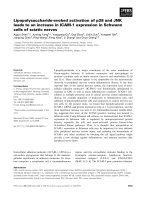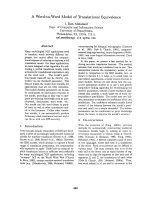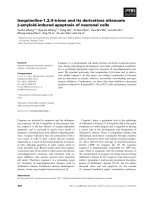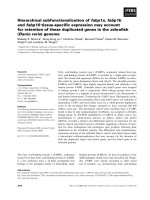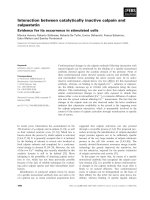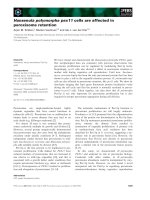báo cáo khoa học: "Genome Medicine: stem cells, genomics and translational research" pptx
Bạn đang xem bản rút gọn của tài liệu. Xem và tải ngay bản đầy đủ của tài liệu tại đây (218.26 KB, 2 trang )
Welcome to a new series of articles on stem cell genomics
to be published in this and upcoming issues of Genome
Medicine. ese contributions sample just a few of the
many exciting developments in the field of stem cells and
genomic research and project ahead to future advances
that will make a clear imprint on medicine.
Simply put, stem cells are defined by two properties:
self-renewal, the generation of more identical cells, and
developmental potency, the capacity to give rise to more
differentiated cells. Stem cells come in different ‘flavors’.
Blood-forming (hematopoietic) stem cells (HSCs), which
sustain blood formation through our entire lives, are
restricted in their developmental potential to generate
only blood cell lineages. On the other hand, embryonic
stem (ES) cells can produce the entire repertoire of cells
of the body, a property called pluripotency. Although the
varieties of stem cells are diverse, it is increasingly
evident that fundamental principles and mechanisms
underlie self-renewal and differentiation, such that dis-
parate research communities are brought together by
common biological themes.
From all the recent excitement in the media about new
developments in stem cells, one might think that stem
cells were hitherto unknown. Nothing can be further
from the truth. Indeed, bone marrow transplantation
(BMT), a life-saving procedure for which the Nobel Prize
was awarded to E Donnall omas in 1990, has been
used for more than three decades to treat aplastic anemia
and leukemia [1]. Remarkably, BMT was developed
empirically through animal and human experimentation
before the identification and characterization of HSCs.
e extraordinary history of BMT and its clinical
development have much to teach us now about how to
turn current strategies in the stem cell field into new
therapies. For example, although first conceived to treat
blood disorders, BMT is gaining momentum in the
treatment of non-hematological and non-malignant
diseases [2].
Current excitement regarding stem cells rests on
several converging themes. e derivation of ES cells,
first of mouse and then of human origin, provided a
platform for the study of pluripotency and the in vitro
generation of different cell types. Recent advances in our
understanding of the molecular mechanisms underlying
lineage determination and differentiation have fueled
methods for the interconversion of cells of different
lineages. In the most dramatic version of such cellular
gym nastics, Shinya Yamanaka and colleagues [3] demon-
strated that a small cocktail of regulatory factors can turn
virtually any somatic cell into a pluripotent, ES-like cell
in a process known as cellular reprogramming. ese
induced pluripotent stem (iPS) cells have become the
focus of brigades of investigators, particularly because
they provide a system in which to generate pluripotent
cells from an individual of a specific genetic constitution
(disease state), giving birth to the notion of ‘disease in the
dish’.
Improved high-throughput methods, mostly supported
by enhanced protein and DNA sequencing platforms, are
being used to characterize the cellular proteome, trans-
criptome, and epigenome (DNA methylation and histone
modifications) in comprehensive and exhaustive detail.
e vast data from these approaches provide a framework
in which to consider the molecular mechanisms under-
lying cell fate decisions. As cell choice is at the heart of
stem cell biology, this knowledge base will guide future
research into manipulating normal or disease-related
cells for ultimate therapeutic benefit.
is series of articles provides a sense of the breadth
and scope of the contemporary stem cell scene. e field
touches nearly every corner of medical science. What can
we reasonably expect in the coming years? Making
predictions is a risky business; nonetheless, I will try.
First, the exploitation of ‘disease in a dish’ should lead to
critical new insights into disease processes and stimulate
new therapeutic strategies. Second, we should anticipate
the development of new therapies based on the stimu-
lation of endogenous stem cells for tissue repair or for
reversing the effects of aging, perhaps well before the
development of cells as regenerative medicine products.
ird, the use of specific cell types produced from human
© 2010 BioMed Central Ltd
Genome Medicine: stem cells, genomics and
translational research
Stuart H Orkin*
E D I T O R I A L
*Correspondence:
Dana-Farber Cancer Institute, 450 Brookline Ave., Boston, MA 02116, USA
Orkin Genome Medicine 2011, 3:34
/>© 2011 BioMed Central Ltd
pluripotent cells, especially of defined genotypes, should
improve the screening of drug toxicity and reduce the
overall costs of drug development. Fourth, the connec-
tions between epigenetic regulation in pluripotent cells
and cancer cells will forge innovative approaches to epi-
genetic therapy of malignant conditions, and possibly the
contribution of epigenetic modulation to non-malignant
conditions. Fifth, ex vivo methods for the generation of
specific cell types from pluripotent cells or by direct
lineage interconversion should drive bioengineering and
fuel the next advances in the creation of artificial organs.
And finally, with an increased ability to manipulate and
generate stem cells of various tissues will come the
potential to use gene modification to correct genetic
defects or enhance cellular capacities. Such work should
stimulate advances in somatic gene therapy of disease.
Although the applications of stem cell biology may be
dazzling, it is critical to support fundamental work in the
stem cell arena, as only that will ensure a solid foundation
for clinical translation and lead to those unexpected
discoveries that drive future innovation. We hope that
this series on translational stem cell genomics provides a
glimpse into this remarkable field.
Abbreviations
BMT, bone marrow transplantation; ES cells, embryonic stem cells; HSC,
hematopoietic stem cell.
Published: 7 June 2011
References
1. Thomas ED: Bone marrow transplantation: a review. Semin Hematol 1999,
36:95-103.
2. Smiers FJ, Krishnamurti L, Lucarelli G: Hematopoetic stem cell
transplantation for hemoglobinopathies: current practice and emerging
trends. Pediatri Clin North Am 2010, 57:181-205.
3. Takahaski K, Yamanaka S: Induction of pluripotent stem cells from mouse
embryonic and adult broblast cultures by dened factors. Cell 2006,
126:663-676.
doi:10.1186/gm250
Cite this article as: Orkin SH: Genome Medicine: stem cells, genomics and
translational research. Genome Medicine 2011, 3:35.
Orkin Genome Medicine 2011, 3:34
/>Page 2 of 2

